Exotic
Cryptophlebia peltastica (Meyrick) (Tortricidae: Olethreutinae: Grapholitini)
Common names: litchi moth
FWLFWL:
forewing length; the distance from the base of the forewing to the apex, including fringe : 8.0-13.0 mm
: 8.0-13.0 mm
Adults are brown to reddish brown with a dark brown pretornal spot that is reduced in males. Males have sex scales on the hindwing, hind tibia, and abdomen. Males lack a forewing costal foldforewing costal fold:
a flap or fold at the base of the forewing that contains specialized sex scales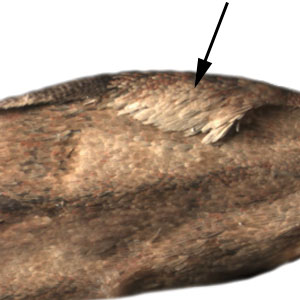 .
.
Male genitalia are characterized by swollen valvaevalva:
an appendage flanking the intromittent organ that is used to clasp the female during copulation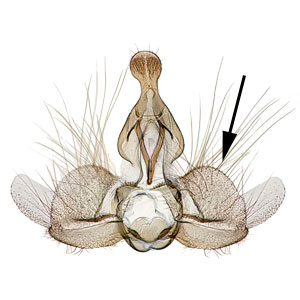 with three large spines on the cuculluscucullus:
with three large spines on the cuculluscucullus:
the distal portion of the male valva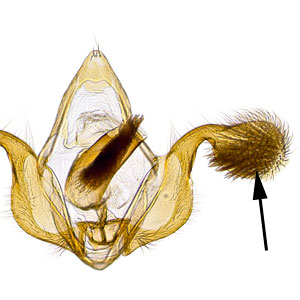 and a densely setosesetose:
and a densely setosesetose:
covered with setae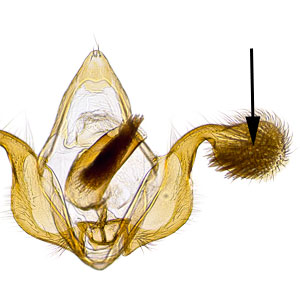 distaldistal:
distaldistal:
farthest from body, distant from point of attachment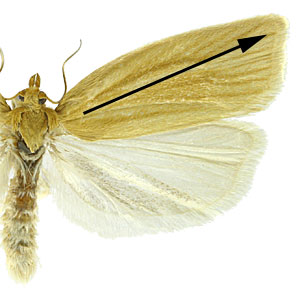 margin. Female genitalia are characterized by an ovate sterigmasterigma:
margin. Female genitalia are characterized by an ovate sterigmasterigma:
the sclerotized region surrounding the female ostium bursae 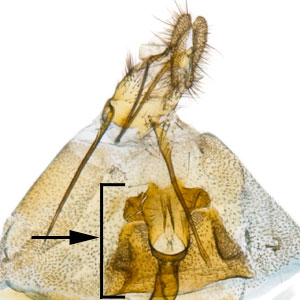 that is surrounded with, and fused to, the posteriorposterior:
that is surrounded with, and fused to, the posteriorposterior:
after, to the rear, toward anal end 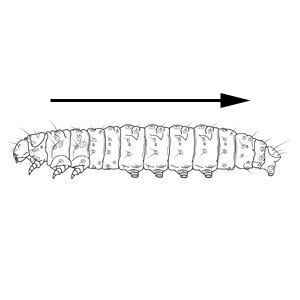 margin of sternum VII and two signasignum:
margin of sternum VII and two signasignum:
a sclerotized projection or patch on the interior of the corpus bursae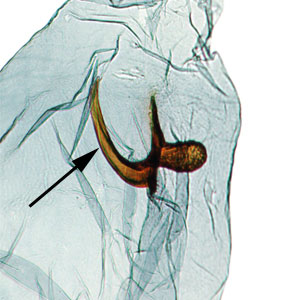 in the corpus bursaecorpus bursae:
in the corpus bursaecorpus bursae:
a dilated membranous sac at the anterior end of the bursa copulatrix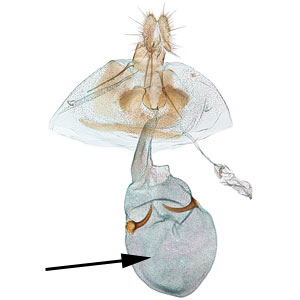 .
.
The following account is summarized from Williams (1953)Williams (1953):
Williams, J. R. 1953. The larvae and pupae of some important Lepidoptera. Bulletin of Entomological Research. 43: 691-701., Timm (2005)Timm (2005):
Timm, A. E. 2005. Morphological and molecular studies of Tortricid moths of economic importance to the South African fruit industry. Ph.D. dissertation, Stellenbosch University, South Africa. 127 pp., and Rentel (2013)Rentel (2013):
Rentel, M. Morphology and taxonomy of tortricid moth pests attacking fruit crops in South Africa. Ph.D. dissertation, Stellenbosch University, South Africa. 133 pp..
Mature larva approximately 20 mm in length; head dark brown; body reddish to pink; anal fork absent. Other characters likely similar to those found in C. illepida and C. ombrodelta. Other diagnostic features of Cryptophlebia larvae include: T1 prespiracular pinaculumpinaculum:
flattened sclerotized plates on a caterpillar that bear the setae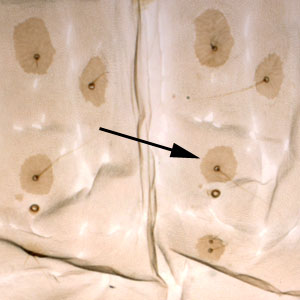 extends below the spiracle; SV counts on A1,2,7,8,9 as 3:3:2(3):2(1):1; SV seta on A8 and A9 bi setosesetose:
extends below the spiracle; SV counts on A1,2,7,8,9 as 3:3:2(3):2(1):1; SV seta on A8 and A9 bi setosesetose:
covered with setae ; spiracle on A8 near posteriorposterior:
; spiracle on A8 near posteriorposterior:
after, to the rear, toward anal end  margin of segment and displaced dorsally; L group on A9 usually trisetose (occasionally bisetose); D1 and SD1 setae on same pinaculumpinaculum:
margin of segment and displaced dorsally; L group on A9 usually trisetose (occasionally bisetose); D1 and SD1 setae on same pinaculumpinaculum:
flattened sclerotized plates on a caterpillar that bear the setae on A9; and D2 setae on shared saddlesaddle:
on A9; and D2 setae on shared saddlesaddle:
in reference to the D2 pinacula on larval segment A9; both setae are on a single, fused pinaculum in the mid-dorsal region of the segment  pinaculumpinaculum:
pinaculumpinaculum:
flattened sclerotized plates on a caterpillar that bear the setae on A9.
on A9.
Detailed figures of larval chaetotaxychaetotaxy:
the arrangement of setae (in reference to Lepidoptera larvae), often depicted on a "setal map"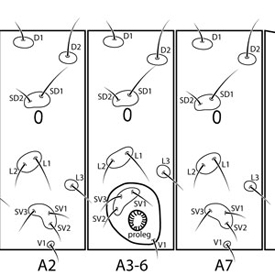 are available in Timm (2005)Timm (2005):
are available in Timm (2005)Timm (2005):
Timm, A. E. 2005. Morphological and molecular studies of Tortricid moths of economic importance to the South African fruit industry. Ph.D. dissertation, Stellenbosch University, South Africa. 127 pp. and Rentel (2013)Rentel (2013):
Rentel, M. Morphology and taxonomy of tortricid moth pests attacking fruit crops in South Africa. Ph.D. dissertation, Stellenbosch University, South Africa. 133 pp..
Adults of most Cryptophlebia species are superficially similar and are often mixed in museum collections. A genitalic dissection is usually necessary to confirm identity. The three species treated here, C. illepida, C. ombrodelta, and C. peltastica, can be separated by genitalic characters and geographic distribution, as outlined in the following table:
| Cryptophlebia species | Male valvavalva: an appendage flanking the intromittent organ that is used to clasp the female during copulation  |
Female sterigmasterigma: the sclerotized region surrounding the female ostium bursae  |
Distribution |
|---|---|---|---|
| illepida | Two large spines, multiple rows of marginal spines | Wide, V-shaped | Hawaii |
| ombrodelta | Three large spines | Narrow, V-shaped, separate | Australia, Guam, Japan, India, Southeast Asia, Hawaii (int.) |
| peltastica | Three large spines, margin densely setosesetose: covered with setae  |
Narrow, ovate, deeply inset | Africa, Seychelles, Mauritius, Guam (int.) |
The following account is summarized from Newton & Crause (1990).
Development of C. peltastica is continuous, and adults are present year-round. Females lay eggs singly on fruit. Larvae tunnel through the skin and into the fruit, and feed on the seeds. Larval development is complete in 2-4 weeks. Pupation occurs in the fruit or in the ground. Adults emerge in 1-2 weeks.
Cryptophlebia peltastica is the primary pest of litchi in South Africa and Mauritius, with larvae damaging up to 20% of fruits in commercial orchards. This species is also a pest of macadamia in South Africa. Larvae have been recorded feeding on a variety of plants, and their polyphagous nature allows them to continue development when primary hosts are unavailable.
| Host plant | Host plant family | Reference(s) |
| Acacia karroo | Fabaceae | McGeoch 1993McGeoch 1993: McGeoch, M. A. 1993. The Microlepidoptera associated with a fungus gall on Acacia karroo Hayne in South Africa. African Entomology. 1: 49-56.; McGeoch & Kruger 1994; Kruger 1998Kruger 1998: Kruger, M. 1998. Identification of the adults of Lepidoptera inhabiting Ravenelia macowaniana Pazschke (Uredinales) galls on Acaia karroo Hayne (Fabaceae) in southern Africa. African Entomology. 6: 55-74. |
| Bauhinia sp. | Fabaceae | Bradley 1953aBradley 1953a: Bradley, J. D. 1953. Some important species of the genus Cryptophlebia Walsingham, 1899, with descriptions of three new species (Lepidoptera: Olethreutidae). Bulletin of Entomological Research. 43: 679-689.; Clarke 1976Clarke 1976: Clarke, J. F. G. 1976. Microlepidoptera: Tortricoidea. Insects of Micronesia. 9: 1-144. |
| Caesalpinia pulcherrima | Fabaceae | Clarke 1976Clarke 1976: Clarke, J. F. G. 1976. Microlepidoptera: Tortricoidea. Insects of Micronesia. 9: 1-144. |
| Canavalia ensiformis | Fabaceae | Meyrick 1930Meyrick 1930: Meyrick, E. 1930. Exotic Microlepidoptera. 3(19): 577-608.; Ghesquiere 1940Ghesquiere 1940: Ghesquiere, J. 1940. Catalogues raisonneacute;s de la Faune Entomologique du Congo Belge. Leacute;pidoptegrave;res, Microleacute;pidoptegrave;res (I). Ann. Mus. Congo Belge. C, Zool. Ser. 3(2): 1-120.; Bradley 1953aBradley 1953a: Bradley, J. D. 1953. Some important species of the genus Cryptophlebia Walsingham, 1899, with descriptions of three new species (Lepidoptera: Olethreutidae). Bulletin of Entomological Research. 43: 679-689. |
| Canavalia sp. | Fabaceae | Clarke 1976Clarke 1976: Clarke, J. F. G. 1976. Microlepidoptera: Tortricoidea. Insects of Micronesia. 9: 1-144. |
| Ceratonia siliqua | Fabaceae | Bradley 1953aBradley 1953a: Bradley, J. D. 1953. Some important species of the genus Cryptophlebia Walsingham, 1899, with descriptions of three new species (Lepidoptera: Olethreutidae). Bulletin of Entomological Research. 43: 679-689.; USNM collectionUSNM collection: USNM collection. Based on identified reared specimens in the collection of the National Museum of Natural History, Washington, D.C. |
| Delonix regia | Fabaceae | Bradley 1953aBradley 1953a: Bradley, J. D. 1953. Some important species of the genus Cryptophlebia Walsingham, 1899, with descriptions of three new species (Lepidoptera: Olethreutidae). Bulletin of Entomological Research. 43: 679-689.; Clarke 1976Clarke 1976: Clarke, J. F. G. 1976. Microlepidoptera: Tortricoidea. Insects of Micronesia. 9: 1-144. |
| Gleditsia triacanthos | Fabaceae | Clarke 1976Clarke 1976: Clarke, J. F. G. 1976. Microlepidoptera: Tortricoidea. Insects of Micronesia. 9: 1-144. |
| Piptadenia sp. | Fabaceae | Clarke 1976Clarke 1976: Clarke, J. F. G. 1976. Microlepidoptera: Tortricoidea. Insects of Micronesia. 9: 1-144. |
| Schotia afra | Fabaceae | Taylor 1951Taylor 1951: Taylor, J. S. 1951. Notes on Lepidoptera in the Eastern Cape Province (Part II). Journal of the Entomological Society of South Africa. 14: 94-126.; Clarke 1976Clarke 1976: Clarke, J. F. G. 1976. Microlepidoptera: Tortricoidea. Insects of Micronesia. 9: 1-144. |
| Tamarindus indica | Fabaceae | Bradley 1953aBradley 1953a: Bradley, J. D. 1953. Some important species of the genus Cryptophlebia Walsingham, 1899, with descriptions of three new species (Lepidoptera: Olethreutidae). Bulletin of Entomological Research. 43: 679-689.; Clarke 1976Clarke 1976: Clarke, J. F. G. 1976. Microlepidoptera: Tortricoidea. Insects of Micronesia. 9: 1-144.; USNM collectionUSNM collection: USNM collection. Based on identified reared specimens in the collection of the National Museum of Natural History, Washington, D.C. |
| Citrus x sinensis | Rutaceae | Clarke 1976Clarke 1976: Clarke, J. F. G. 1976. Microlepidoptera: Tortricoidea. Insects of Micronesia. 9: 1-144. |
| Litchi chinensis | Sapindaceae | Clarke 1976Clarke 1976: Clarke, J. F. G. 1976. Microlepidoptera: Tortricoidea. Insects of Micronesia. 9: 1-144.; Newton & Crause 1990 |
| Litchi sp. | Sapindaceae | Bradley 1953aBradley 1953a: Bradley, J. D. 1953. Some important species of the genus Cryptophlebia Walsingham, 1899, with descriptions of three new species (Lepidoptera: Olethreutidae). Bulletin of Entomological Research. 43: 679-689. |
View full screen host table here
Cryptophlebia peltastica is broadly distributed in Africa and has also been recorded from the Seychelles, Madagascar, and Mauritius. It has been introduced to Guam (Bradley 1953).